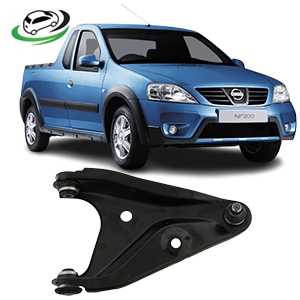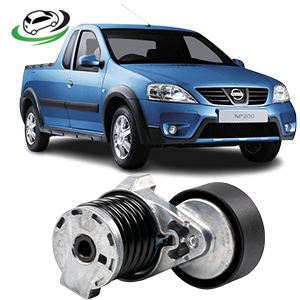-10%
Get Nissan Pick Up NP200 Tensioner Assy-Belt For K9K Engines 11955-00Q0K
The belt tensioner assembly is a vital component of the engine system in many vehicles, including the Nissan NP200. Its primary function is to maintain the proper tension on the serpentine or drive belt, ensuring smooth operation of various engine accessories like the alternator, power steering pump, water pump, and air conditioning compressor. In this detailed 1000-word guide, we will explore the design, function, types, benefits, common problems, and maintenance tips for the belt tensioner assembly.
1. What Is a Belt Tensioner Assembly?
The belt tensioner assembly is a spring-loaded or hydraulic device designed to apply constant pressure on the drive or serpentine belt. This tension ensures that the belt remains tight, allowing it to transmit power efficiently to the various accessories driven by the engine. Without the proper amount of tension, the belt can slip, leading to reduced efficiency or failure of these accessories.
In modern vehicles like the Nissan NP200, the serpentine belt is often used to drive multiple components at once, making the tensioner even more critical for maintaining engine performance.
2. Components of a Belt Tensioner Assembly
The belt tensioner assembly is made up of several key components, each contributing to its overall function:
- Tensioner Arm: This is the main arm that houses the tensioner pulley and applies pressure on the belt.
- Tensioner Pulley: A smooth or ribbed pulley that the belt runs across. It ensures smooth movement of the belt while the tension is applied.
- Spring Mechanism: The tensioner typically includes a spring-loaded mechanism (coil or torsion spring) that keeps constant pressure on the belt, even as it stretches or contracts due to engine operation.
- Hydraulic Damper (in some cases): In more advanced tensioners, a hydraulic damper is used to help smooth out the motion and absorb vibrations, reducing wear on the belt and pulley.
- Mounting Bracket: The tensioner assembly is bolted to the engine block via a mounting bracket, which holds it in place.
3. Function of the Belt Tensioner Assembly
The primary purpose of the belt tensioner assembly is to keep the serpentine or drive belt properly tensioned. Here’s a closer look at its role in the engine’s operation:
- Maintain Constant Tension: Over time, a belt can stretch due to heat and friction. The tensioner compensates for this by applying constant pressure, ensuring the belt remains tight enough to drive all the engine accessories without slipping.
- Absorb Belt Fluctuations: During engine operation, variations in speed, load, and temperature can cause fluctuations in belt tension. The tensioner absorbs these fluctuations, preventing the belt from bouncing or fluttering, which could lead to premature wear or failure.
- Reduce Wear on Components: By keeping the belt tension stable, the tensioner assembly helps reduce wear on both the belt and the pulleys it drives. This, in turn, extends the lifespan of engine accessories such as the alternator and power steering pump.
- Prevent Belt Slippage: A loose belt can slip, reducing its ability to transmit power to the engine accessories. This can lead to issues like the alternator not charging the battery properly, the air conditioner malfunctioning, or the power steering becoming unresponsive.
4. Types of Belt Tensioner Assemblies
There are two main types of belt tensioners used in automotive applications:
- Manual Tensioners: In older vehicles, belt tensioners had to be adjusted manually. Mechanics would use tools to loosen the tensioner, adjust the belt tension, and then tighten it back down. Manual tensioners are rarely used in modern vehicles, as they require regular adjustment and can be inconvenient.
- Automatic (Spring-Loaded) Tensioners: Most modern vehicles, including the Nissan NP200, use automatic belt tensioners. These tensioners are spring-loaded and automatically adjust to maintain the correct belt tension without the need for manual intervention. They are more convenient and reliable than manual tensioners, making them the preferred choice in most automotive applications.
Some advanced belt tensioners also incorporate a hydraulic damper to reduce vibrations and provide smoother operation.
5. Benefits of a Properly Functioning Belt Tensioner Assembly
A properly functioning belt tensioner assembly provides several critical benefits for the vehicle’s engine and overall performance:
- Optimal Accessory Operation: The tensioner ensures that the belt drives the engine accessories (like the alternator, power steering pump, and A/C compressor) at the proper speed, enabling them to operate efficiently.
- Reduced Belt Wear: By maintaining constant tension on the belt, the tensioner prevents excessive wear and prolongs the life of the belt.
- Improved Engine Efficiency: A belt that is too loose or too tight can cause inefficiencies, such as slippage or excessive strain on the engine. The tensioner helps maintain engine efficiency by ensuring the belt operates within its optimal tension range.
- Reduced Noise: A properly tensioned belt runs smoothly and quietly, while a loose or worn belt may squeal or produce other noises. The tensioner eliminates unwanted noise by keeping the belt taut.
- Increased Safety: The belt tensioner plays a role in maintaining the functionality of key engine accessories like the power steering and alternator. If the tensioner fails, it could lead to loss of these essential functions, compromising the safety and drivability of the vehicle.
6. Common Problems with Belt Tensioner Assemblies
Like any mechanical component, the belt tensioner assembly can wear out over time or develop problems. Some common issues include:
- Worn or Damaged Pulley: The tensioner pulley can develop wear over time, especially if the bearings inside the pulley start to fail. A worn or damaged pulley can cause belt slippage, noise, and premature belt wear.
- Weak or Broken Spring: In automatic tensioners, the spring is responsible for applying the necessary tension to the belt. If the spring weakens or breaks, the tensioner may not be able to maintain proper belt tension, leading to belt slippage or failure.
- Hydraulic Damper Failure: In tensioners equipped with a hydraulic damper, failure of the damper can cause the tensioner arm to oscillate excessively, leading to vibrations, noise, and uneven belt wear.
- Misalignment: A misaligned tensioner can cause the belt to run at an angle, leading to uneven wear or belt failure. Misalignment is often caused by incorrect installation or wear in the tensioner arm or mounting bracket.
- Squealing or Chirping Noises: One of the most common symptoms of a failing tensioner is a squealing or chirping noise coming from the engine. This is often caused by a worn pulley or a loose belt due to insufficient tension.
7. Maintenance and Replacement of the Belt Tensioner Assembly
Proper maintenance of the belt tensioner assembly is essential to ensure its longevity and the reliable operation of the engine accessories. Here are some maintenance tips:
- Regular Inspection: During routine vehicle maintenance, inspect the belt tensioner for signs of wear, such as pulley wobble, cracks, or unusual noises. Check the belt for any visible signs of wear or damage, as a worn belt can put extra strain on the tensioner.
- Replace the Belt: Serpentine belts typically last between 60,000 and 100,000 miles. It’s a good idea to replace the belt during routine maintenance or when it shows signs of wear (cracking, fraying, or glazing). When replacing the belt, always inspect and consider replacing the tensioner at the same time.
- Listen for Unusual Noises: If you hear any squealing or chirping noises from the engine, it could be a sign that the belt tensioner is failing. Don’t ignore these noises, as they can indicate more serious problems down the road.
- Replace Worn Tensioner: If the tensioner shows signs of wear, such as a weak spring or damaged pulley, it should be replaced. Replacing a faulty tensioner before it fails can prevent more expensive repairs down the road.
8. Replacing the Belt Tensioner Assembly
Replacing the belt tensioner assembly is a relatively straightforward process but requires basic mechanical skills and tools. Here’s a general overview of the steps involved:
- Remove the Serpentine Belt: Use a wrench or belt tensioner tool to relieve the tension on the serpentine belt, and then remove the belt from the engine pulleys.
- Unbolt the Tensioner: Remove the bolts that secure the tensioner to the engine block. Keep track of any spacers or washers used in the mounting process.
- Install the New Tensioner: Position the new tensioner assembly in place and secure it with the appropriate bolts. Be sure to torque the bolts to the manufacturer’s specifications.
- Reinstall the Serpentine Belt: Route the serpentine belt over the engine pulleys, following the correct belt routing diagram for your vehicle. Use the tensioner tool to release tension and fit the belt over the pulleys.
- Check Belt Tension and Alignment: Once the new tensioner is installed, check the belt tension and alignment to ensure that everything is functioning properly.
9. Conclusion
The belt tensioner assembly is an integral part of the engine’s serpentine belt system, playing a crucial role in maintaining the proper tension on the belt and ensuring that all engine accessories function correctly. Regular inspection, maintenance, and timely replacement of worn tensioners can prevent belt failure, reduce noise, and ensure optimal engine performance. By understanding how the tensioner works and how to identify signs of failure, vehicle owners can keep their engines running smoothly and avoid costly repairs down the road.
Follow us on Facebook for more parts.



